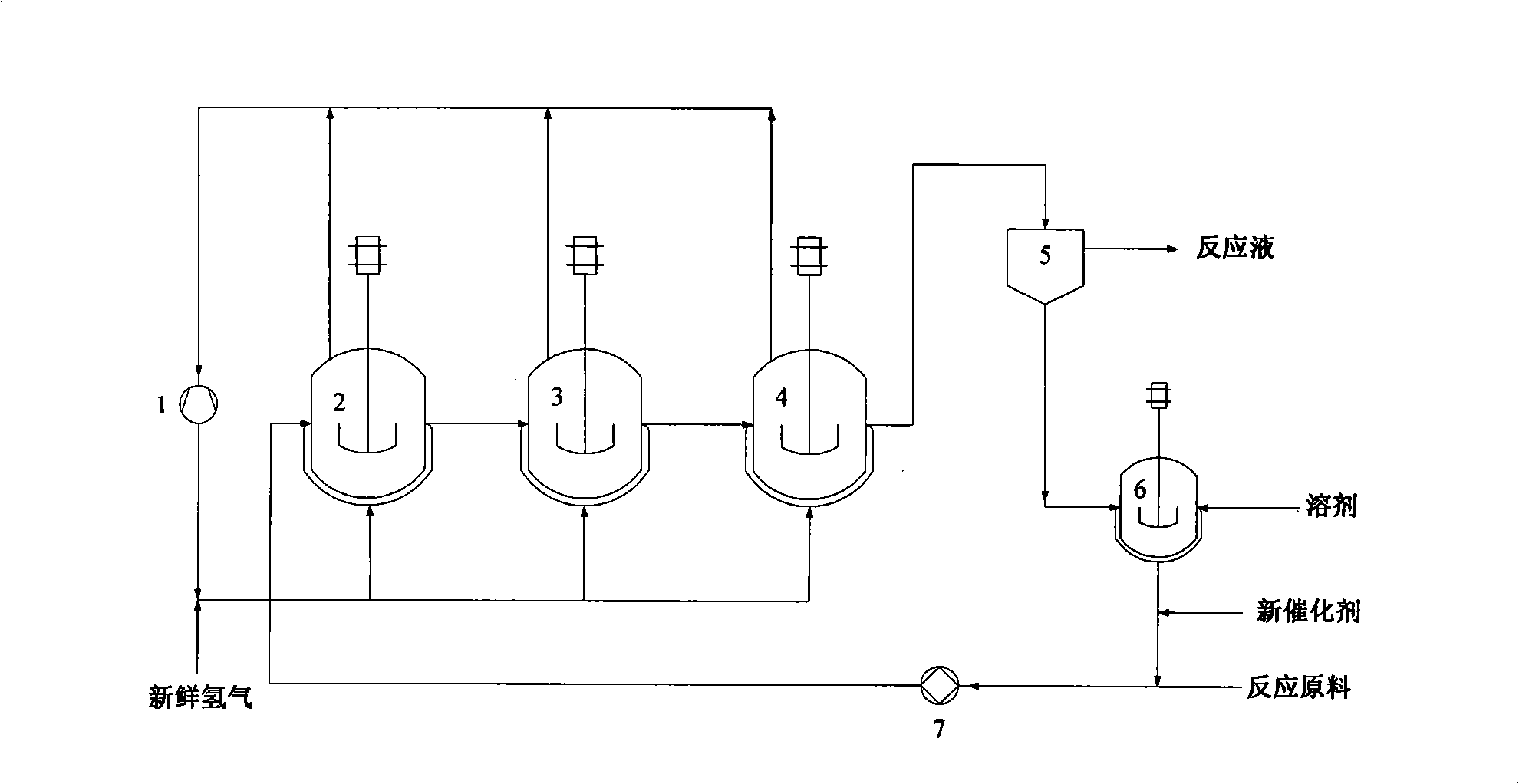Process for preparation of meta-benzene dimethanamine by continuous hydrogenation reaction in stirring vessel
A technology for m-xylylenediamine and isophthalonitrile is applied in the field of continuous hydrogenation of isophthalonitrile stirred tank to prepare m-xylylenediamine, which can solve the problems of easy wear and tear of catalysts, broken and loss, complicated operation steps, and equipment utilization rate. Low problems, to achieve the effect of inhibiting the formation of by-products, high hydrogen utilization rate, and high equipment utilization rate
- Summary
- Abstract
- Description
- Claims
- Application Information
AI Technical Summary
Problems solved by technology
Method used
Image
Examples
Embodiment 1
[0026] Embodiment 1 adopts the method for continuous hydrogenation of the present invention to prepare m-xylylenediamine, and its technological process is as follows figure 1 shown.
[0027]The hydrogenation reactor is composed of three stirred tanks 2, 3 and 4 connected in series. In the hydrogenation reactor, the mixture of isophthalonitrile and solvent and hydrogen are contacted with the granular solid catalyst to carry out continuous hydrogenation reaction. The reaction material and catalyst composed of isophthalonitrile and solvent are sent into the first stirred tank reactor 2 through the conveying device 7, and then overflow from the upper part of the first stirred tank reactor 2 into the second stirred tank reactor 3 , and then overflows from the upper part of the second stirred tank reactor 3 into the third stirred tank reactor 4. The hydrogen enters the three stirred tank reactors 2, 3 and 4 respectively, and the unreacted hydrogen from the tops of the three stirred...
Embodiment 2~3
[0031] Examples 2 and 3 prepared m-xylylenediamine by continuous hydrogenation according to the process method of Example 1. The difference lies in the difference in hydrogenation reaction temperature and pressure.
[0032] The reaction results are shown in Table 1.
[0033] Table 1 Raney nickel catalyzed continuous hydrogenation of isophthalonitrile to prepare m-xylylenediamine reaction results
[0034]
Embodiment 4~6
[0036] Examples 4-6 According to the process method of Example 1, m-xylylenediamine was prepared by continuous hydrogenation, using an amorphous nickel catalyst.
[0037] According to the process method of Example 1, m-xylylenediamine was prepared by continuous hydrogenation. Reaction raw material composition: 20% (weight) of isophthalonitrile, 40% (weight) of methanol, 40% (weight) of toluene, use commercially available amorphous nickel catalyst, and its nickel content is 88.1% (weight). The feed rate of reaction raw materials is 180 kg / hour, the reaction temperature and pressure are shown in Table 2, the stirring speed is 200 rpm, the solid catalyst and liquid weight ratio in the reactor is 0.07: 1, the hydrogen circulation rate is 85 standard cubic meters / hour, and the material is in The total residence time in the reactor was 4 hours. Catalyst regeneration conditions: temperature 60°C, pressure 6.2MPa, solid catalyst to solvent weight ratio in regenerator 0.2:1, regenerat...
PUM
 Login to View More
Login to View More Abstract
Description
Claims
Application Information
 Login to View More
Login to View More - R&D
- Intellectual Property
- Life Sciences
- Materials
- Tech Scout
- Unparalleled Data Quality
- Higher Quality Content
- 60% Fewer Hallucinations
Browse by: Latest US Patents, China's latest patents, Technical Efficacy Thesaurus, Application Domain, Technology Topic, Popular Technical Reports.
© 2025 PatSnap. All rights reserved.Legal|Privacy policy|Modern Slavery Act Transparency Statement|Sitemap|About US| Contact US: help@patsnap.com



